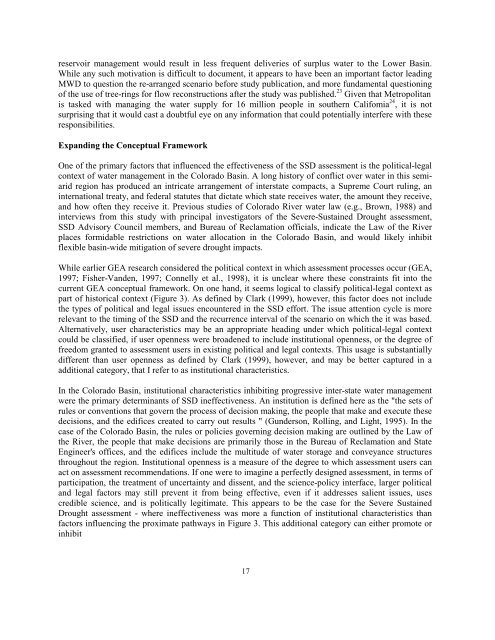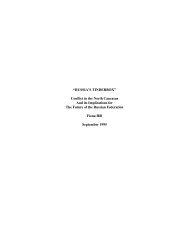Global Environmental Assessment Project - Belfer Center for ...
Global Environmental Assessment Project - Belfer Center for ...
Global Environmental Assessment Project - Belfer Center for ...
Create successful ePaper yourself
Turn your PDF publications into a flip-book with our unique Google optimized e-Paper software.
eservoir management would result in less frequent deliveries of surplus water to the Lower Basin.<br />
While any such motivation is difficult to document, it appears to have been an important factor leading<br />
MWD to question the re-arranged scenario be<strong>for</strong>e study publication, and more fundamental questioning<br />
of the use of tree-rings <strong>for</strong> flow reconstructions after the study was published. 23 Given that Metropolitan<br />
is tasked with managing the water supply <strong>for</strong> 16 million people in southern Califomia 24 , it is not<br />
surprising that it would cast a doubtful eye on any in<strong>for</strong>mation that could potentially interfere with these<br />
responsibilities.<br />
Expanding the Conceptual Framework<br />
One of the primary factors that influenced the effectiveness of the SSD assessment is the political-legal<br />
context of water management in the Colorado Basin. A long history of conflict over water in this semiarid<br />
region has produced an intricate arrangement of interstate compacts, a Supreme Court ruling, an<br />
international treaty, and federal statutes that dictate which state receives water, the amount they receive,<br />
and how often they receive it. Previous studies of Colorado River water law (e.g., Brown, 1988) and<br />
interviews from this study with principal investigators of the Severe-Sustained Drought assessment,<br />
SSD Advisory Council members, and Bureau of Reclamation officials, indicate the Law of the River<br />
places <strong>for</strong>midable restrictions on water allocation in the Colorado Basin, and would likely inhibit<br />
flexible basin-wide mitigation of severe drought impacts.<br />
While earlier GEA research considered the political context in which assessment processes occur (GEA,<br />
1997; Fisher-Vanden, 1997; Connelly et al., 1998), it is unclear where these constraints fit into the<br />
current GEA conceptual framework. On one hand, it seems logical to classify political-legal context as<br />
part of historical context (Figure 3). As defined by Clark (1999), however, this factor does not include<br />
the types of political and legal issues encountered in the SSD ef<strong>for</strong>t. The issue attention cycle is more<br />
relevant to the timing of the SSD and the recurrence interval of the scenario on which the it was based.<br />
Alternatively, user characteristics may be an appropriate heading under which political-legal context<br />
could be classified, if user openness were broadened to include institutional openness, or the degree of<br />
freedom granted to assessment users in existing political and legal contexts. This usage is substantially<br />
different than user openness as defined by Clark (1999), however, and may be better captured in a<br />
additional category, that I refer to as institutional characteristics.<br />
In the Colorado Basin, institutional characteristics inhibiting progressive inter-state water management<br />
were the primary determinants of SSD ineffectiveness. An institution is defined here as the "the sets of<br />
rules or conventions that govern the process of decision making, the people that make and execute these<br />
decisions, and the edifices created to carry out results " (Gunderson, Rolling, and Light, 1995). In the<br />
case of the Colorado Basin, the rules or policies governing decision making are outlined by the Law of<br />
the River, the people that make decisions are primarily those in the Bureau of Reclamation and State<br />
Engineer's offices, and the edifices include the multitude of water storage and conveyance structures<br />
throughout the region. Institutional openness is a measure of the degree to which assessment users can<br />
act on assessment recommendations. If one were to imagine a perfectly designed assessment, in terms of<br />
participation, the treatment of uncertainty and dissent, and the science-policy interface, larger political<br />
and legal factors may still prevent it from being effective, even if it addresses salient issues, uses<br />
credible science, and is politically legitimate. This appears to be the case <strong>for</strong> the Severe Sustained<br />
Drought assessment - where ineffectiveness was more a function of institutional characteristics than<br />
factors influencing the proximate pathways in Figure 3. This additional category can either promote or<br />
inhibit<br />
17
















